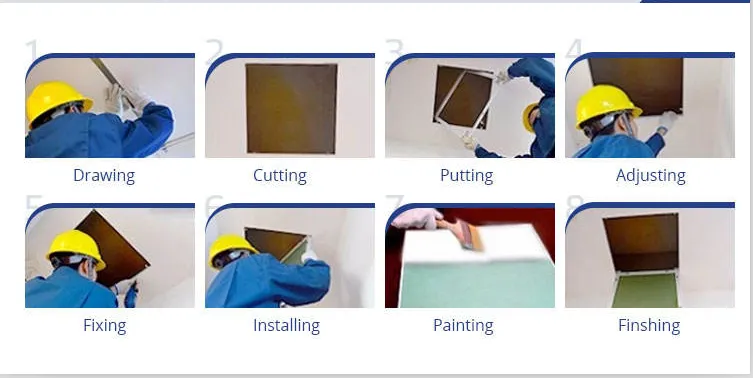Dec . 16, 2024 11:40 Back to list
drop ceiling grid materials
Understanding Drop Ceiling Grid Materials
When it comes to interior design, particularly in commercial and industrial spaces, the choice of ceiling materials is crucial. One popular option is the drop ceiling, also known as a suspended ceiling, which offers a variety of benefits such as sound insulation, aesthetic versatility, and ease of installation. However, the effectiveness of a drop ceiling heavily relies on the quality and type of grid materials used. In this article, we will explore different drop ceiling grid materials, their advantages, and considerations when selecting the right one for your space.
What is a Drop Ceiling?
A drop ceiling consists of a grid framework that supports lightweight tiles or panels. The grid system is suspended from the original ceiling using wires or rods, creating a space between the actual ceiling and the drop ceiling. This space can be used for plumbing, electrical wiring, or HVAC systems, making drop ceilings an excellent choice for both aesthetics and functionality.
Types of Drop Ceiling Grid Materials
1. Metal Grids Metal grids, typically made from steel or aluminum, are the most common type used in drop ceilings. They are favored for their durability, strength, and resistance to corrosion. Metal grids often feature a powder-coated finish to enhance their appearance and protect against scratches. They are available in various styles, including exposed, semi-concealed, and concealed grids, allowing for design flexibility.
2. Vinyl Grids Vinyl grids are a lightweight alternative to metal grids. They are created from PVC and offer excellent resistance to moisture, making them ideal for high-humidity areas such as bathrooms or kitchens. Vinyl grids are also available in several colors and textures, providing aesthetic variety. Additionally, their lightweight nature simplifies installation.
3. Wood Grids For a more natural look, wood grids can be used. While they are not as commonly used as metal or vinyl grids, they offer a warm, inviting aesthetic that enhances interior design. Wooden grids often require more maintenance and may not be suitable for areas with high humidity.
4. Acoustic Grids Acoustic grids are designed specifically for sound absorption. They often feature special materials or designs that help reduce noise levels in a room, making them perfect for offices, schools, or auditoriums. Using acoustic tiles in conjunction with these grids can create a harmonious environment with minimized distractions.
Advantages of Drop Ceiling Grid Materials
drop ceiling grid materials

- Ease of Installation One of the primary benefits of drop ceilings is the simplicity of installation. The grid systems are designed for straightforward assembly, allowing for a quicker renovation process compared to traditional ceilings. - Accessibility The space above a drop ceiling is easily accessible, making it simple to repair or upgrade plumbing, electrical, or HVAC systems without extensive construction work.
- Versatility With a variety of grid materials and styles available, drop ceilings can complement diverse aesthetic themes, from modern minimalist to classic vintage
.- Sound Control Certain grid systems, especially when paired with acoustic tiles, can significantly enhance sound performance in a room, making them perfect for noisy environments.
Considerations When Choosing Drop Ceiling Grid Materials
- Weight The weight of the grid material impacts the overall load-bearing capacity of the ceiling. Heavier materials may require more robust support systems.
- Moisture Resistance In areas prone to high humidity, such as bathrooms or kitchens, moisture-resistant materials like vinyl should be prioritized to prevent warping or degradation.
- Aesthetic Appeal The visual impact of the grid should align with the desired interior design. Metal grids may add a modern touch, while wooden grids can offer a rustic charm.
- Budget Costs can vary significantly between different materials, so it’s essential to assess the budget and make an informed decision that balances quality and affordability.
Conclusion
Choosing the right drop ceiling grid material is fundamental to achieving the desired look and functionality of a space. Understanding the various options available—metal, vinyl, wood, and acoustic grids—can empower you to make the best choice for your renovation or construction project. Whether you're looking to enhance sound management, improve aesthetics, or simplify maintenance, there is a drop ceiling grid material tailored to meet your needs. By considering the advantages and specific requirements of your space, you can create an environment that is both visually appealing and highly functional.
-
Durable Ceiling T Grid Systems | Easy InstallationNewsAug.29,2025
-
PVC Gypsum Ceiling: Durable, Laminated Tiles for Modern SpacesNewsAug.28,2025
-
Pvc Gypsum Ceiling Is DurableNewsAug.21,2025
-
Mineral Fiber Board Is DurableNewsAug.21,2025
-
Ceiling Tile Clip Reusable DesignNewsAug.21,2025
-
Ceiling T Grid Modular DesignNewsAug.21,2025







